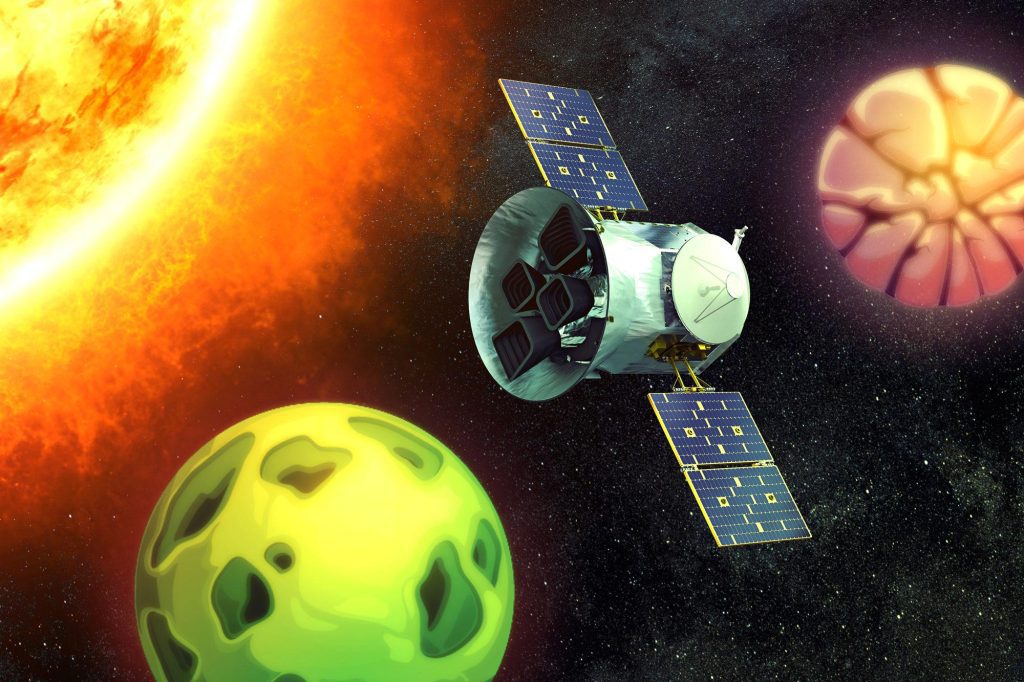اكتشف علماء الفلك في معهد ماساتشوستس للتكنولوجيا نظامًا جديدًا متعدد الكواكب يقع على بعد 10 فرسخ فلكي ، أو حوالي 33 سنة ضوئية ، من الأرض ، مما يجعله أحد أقرب أنظمة الكواكب المتعددة المعروفة لنظامنا. من المحتمل أن يستضيف النجم الموجود في قلب النظام ما لا يقل عن اثنين من الكواكب الأرضية بحجم الأرض. الائتمان: MIT News ، مع شخصية TESS Satellite بإذن من وكالة ناسا
يقع على بعد 33 سنة ضوئية فقط من الأرض ، ويبدو أن النظام يستضيف اثنين من الكواكب الصخرية بحجم الأرض.
تم اكتشاف نظام جديد متعدد الكواكب داخل مجرتنا المجاورة بواسطة علماء الفلك في[{” attribute=””>MIT and elsewhere. It lies just 10 parsecs, or about 33 light-years, from Earth, making it one of the closest known multiplanet systems to our own.
At the heart of the system lies a small and cool M-dwarf star, named HD 260655, and astronomers have found that it hosts at least two terrestrial, Earth-sized planets. The rocky worlds have relatively tight orbits, exposing the planets to temperatures that are too high to sustain liquid surface water. Therefore, they are unlikely to be habitable.
Nevertheless, scientists are excited about this system because the proximity and brightness of its star will give them a closer look at the properties of the planets and signs of any atmosphere they might hold.
“Both planets in this system are each considered among the best targets for atmospheric study because of the brightness of their star,” says Michelle Kunimoto, a postdoc in MIT’s Kavli Institute for Astrophysics and Space Research and one of the discovery’s lead scientists. “Is there a volatile-rich atmosphere around these planets? And are there signs of water or carbon-based species? These planets are fantastic test beds for those explorations.”
The team will present its discovery on June 15, 2022, at the meeting of the American Astronomical Society in Pasadena, California. Team members at MIT include Katharine Hesse, George Ricker, Sara Seager, Avi Shporer, Roland Vanderspek, and Joel Villaseñor, along with collaborators from institutions around the world.

Illustration of NASA’s Transiting Exoplanet Survey Satellite (TESS) at work. Credit: NASA’s Goddard Space Flight Center
Data power
The new planetary system was initially identified by NASA’s Transiting Exoplanet Survey Satellite (TESS), an MIT-led mission that is designed to observe the nearest and brightest stars, and detect periodic dips in light that could signal a passing planet.
In October 2021, Kunimoto, a member of MIT’s TESS science team, was monitoring the satellite’s incoming data when she noticed a pair of periodic dips in starlight, or transits, from the star HD 260655.
She ran the detections through the mission’s science inspection pipeline, and the signals were soon classified as two TESS Objects of Interest, or TOIs — objects that are flagged as potential planets. The same signals were also found independently by the Science Processing Operations Center (SPOC), the official TESS planet search pipeline based at NASA Ames. Scientists typically plan to follow up with other telescopes to confirm that the objects are indeed planets.
The process of classifying and subsequently confirming new planets can often take several years. For HD 260655, that process was shortened significantly with the help of archival data.
Soon after Kunimoto identified the two potential planets around HD 260655, Shporer looked to see whether the star was observed previously by other telescopes. As luck would have it, HD 260655 was listed in a survey of stars taken by the High Resolution Echelle Spectrometer (HIRES), an instrument that operates as part of the Keck Observatory in Hawaii. HIRES had been monitoring the star, along with a host of other stars, since 1998, and the researchers were able to access the survey’s publicly available data.
HD 260655 was also listed as part of another independent survey by CARMENES, an instrument that operates as part of the Calar Alto Observatory in Spain. As these data were private, the team reached out to members of both HIRES and CARMENES with the goal of combining their data power.
“These negotiations are sometimes quite delicate,” Shporer notes. “Luckily, the teams agreed to work together. This human interaction is almost as important in getting the data [as the actual observations]. “
سحب الكواكب
في النهاية ، أكد هذا الجهد التعاوني بسرعة وجود كوكبين حول HD 260655 في حوالي ستة أشهر.
للتأكد من أن الإشارات من TESS كانت بالفعل من كوكبين يدوران في المدار ، نظر الباحثون في بيانات كل من HIRES و CARMENES للنجم. كلا المسحين يقيسان تذبذب جاذبية النجم ، والمعروف أيضًا باسم سرعته الشعاعية.
يوضح كونيموتو: “كل كوكب يدور حول نجم سيكون له قوة جاذبية صغيرة على نجمه”. “ما نبحث عنه هو أي حركة طفيفة لذلك النجم يمكن أن تشير إلى جسم ذي كتلة كوكبية يسحبها.”
من كلا مجموعتي البيانات الأرشيفية ، وجد الباحثون علامات ذات دلالة إحصائية على أن الإشارات التي اكتشفها TESS كانت بالفعل كوكبين يدوران في المدار.
يقول شبورر: “ثم عرفنا أن لدينا شيئًا مثيرًا للغاية”.
ثم نظر الفريق عن كثب إلى بيانات TESS لتحديد خصائص كلا الكواكب ، بما في ذلك الفترة المدارية والحجم. لقد قرروا أن الكوكب الداخلي ، الملقب بـ HD 260655b ، يدور حول النجم كل 2.8 يوم ويبلغ حجمه حوالي 1.2 ضعف حجم الأرض. الكوكب الخارجي الثاني ، HD 260655c ، يدور كل 5.7 يوم ويبلغ حجمه 1.5 مرة مثل الأرض.
من بيانات السرعة الشعاعية من HIRES و CARMENES ، تمكن الباحثون من حساب كتلة الكواكب ، والتي ترتبط ارتباطًا مباشرًا بالسعة التي يسحب بها كل كوكب على نجمه. ووجدوا أن الكوكب الداخلي تبلغ كتلته ضعف كتلة الأرض ، بينما تبلغ كتلة الكوكب الخارجي حوالي ثلاث كتل أرضية. من حجمها وكتلتها ، قدر الفريق كثافة كل كوكب. الكوكب الداخلي الأصغر هو أكثر كثافة قليلاً من الأرض ، في حين أن الكوكب الخارجي الأكبر يكون أقل كثافة قليلاً. كلا الكوكبين ، بناءً على كثافتهما ، من المحتمل أن يكونا أرضيين أو صخريين في التكوين.
يقدر الباحثون أيضًا ، بناءً على مداراتهم القصيرة ، أن سطح الكوكب الداخلي عبارة عن تحميص 710 درجة كلفن (818 درجة).[{” attribute=””>Fahrenheit), while the outer planet is around 560 °K (548 °F).
“We consider that range outside the habitable zone, too hot for liquid water to exist on the surface,” Kunimoto says.
“But there might be more planets in the system,” Shporer adds. “There are many multiplanet systems hosting five or six planets, especially around small stars like this one. Hopefully, we will find more, and one might be in the habitable zone. That’s optimistic thinking.”
This research was supported, in part, by NASA, the Max-Planck-Gesellschaft, the Consejo Superior de Investigaciones Científicas, the Ministerio de Economía y Competitividad, and the European Regional Development Fund.

“مدمن ثقافة البوب. عشاق التلفزيون. نينجا الكحول. إجمالي مهووس البيرة. خبير تويتر محترف.”







More Stories
مهمة ستارلينك الثلاثاء من كيب كانافيرال
زخات نيزك Lyrid تبلغ ذروتها. كيف ترى الليلة في ولاية ايوا
سبيس إكس تطلق 23 قمرا صناعيا من طراز ستارلينك وتسجل الهبوط الصاروخي رقم 300 (صور)